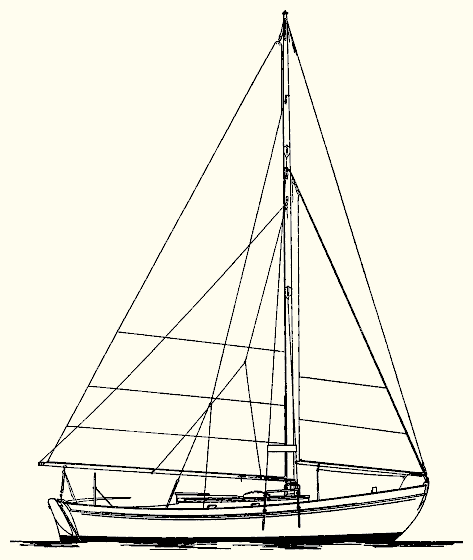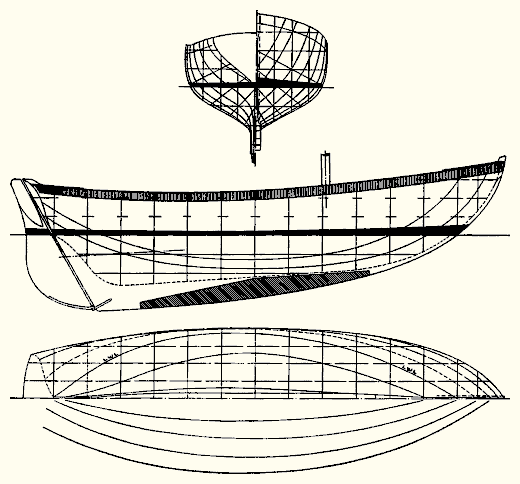

IT is a long jump from the many designs of small boats we have designed in the past for MoToR BoatinG to the design of the relatively large knockabout shown in this issue of the magazine. This latest design shows a shipshape and practical type of auxiliary cruiser and one in which a generous measure of simplicity is woven. In connection with the latter I must say that in these days of intricate mechanical and social developments, simplicity, with all of its old-time charm, is well worth flirting with. If it is not amiss, I should like to mention here that I, with many another, have a deep feeling that ere long many and sundry of us will be gently knocking at its door. At any rate, Shipmates, the premise leans in that direction.

The design this month shows a well modeled hull and one which shows every promise of being a comfortable, able and well behaved cruising yacht, not by any means a racing machine, rather a useful, easily handled craft. The little vessel's overall length is 29 feet 10 inches; the waterline length 25 feet; the breadth 8 feet 9 inches; and the draft 4 feet 10 inches. The freeboard at the bow is 4 feet 8 inches and at the stern 3 feet 5 inches. The displacement is 13,200 pounds which indicates generous room below decks for all the amenities required for comfortable living afloat.
The sail plan shows a jib-head mainsail and staysail. In my younger days this style of rig was always termed a knockabout; and is still a knockabout (not a sloop). Stem-head sloop also properly describes this type of rig, if there are two headsails and no bowsprit. The absence of a bowsprit makes the rig a knockabout. The area of the mainsail is 350 square feet, the area of the staysail 112 square feet; total sail area, 462 square feet. Do not increase the weight of the canvas as specified on the plans; don't forget the reef points, the lazy jacks and the topping lift. It will be observed that only two shrouds each side adorn the design; one headstay and one topmast stay. Also, Shipmates, the absence of spreaders, jumper struts, tangs, winches, and permanent backstays. There are, however, runners -- blessed in use because they lead to the sides of the little vessel rather than to its centerline. The advantages and strength of this arrangement is perfectly obvious to practical minded sailors. Deadeyes and tarred lanyards are also included in the sail plan. A solid mast thus has some flexibility and this it should have. The above would not do for a high-strung racing boat, but has many advantages in a simple type of cruising auxiliary. And the latter type is the subject before us.

The cabin plan of this latest of the family is laid out for the accommodation of a crew of three. There is a single pipe berth forward, stowage space in the fore peak, comfortable seat, hanging locker, sail bin and, tucked behind the main cabin bulkhead. a pump water closet. The main cabin has two built-in berths. There are lockers beneath one of these and beneath the other a water tank. The galley spreads across the after end of the accommodation space. And here we find a shipmate coal range, work table, ice box, sink, and dish shelves. The headroom under the cabin trunk is 5 feet 6 inches; under the companion slide and the skylight a full 6 feet. The motor is installed under the bridge deck and cockpit floor and is a Universal Atomic Four. Speed under power should be a good 7 miles an hour.
The deck plan is worth looking at; its narrow deckhouse, athwartship skylight, deck hatches, and companionway slide; not to forget the strong grab rails and cockpit seats set below the level of the deck. The cleats, somehow, stand in the right locations, the boom frame appeals, the long tiller looks useful, and the 8-inch high bulwarks provide a sure foot-hold against slipping overboard.

The safest and best place for gasoline tanks in any type of boat is in the cockpit, providing this is of self-draining design. We here, therefore, have twin tanks beneath the two cockpit seats. Because the cockpit is water-tight bottom and all four sides any leakage or spillage from the tanks will quickly find its way overboard. Then use globe valves (not shut-off cocks) above the cockpit floor, shutting these rather than the ignition to stop the motor. A tank and piping installation of the above description is as close to perfection as anything can be.

The name is a memento from days long ago at Huntington, Long Island, New York. Unforgettable days at about the beginning of this now half-spent century -- to be precise, 1906. Then Cottrell Wheeler and I ran the Red Boat Shop and among the worthies that worked with and for us was Captain Cicero Sammis, a gray-bearded, kindly man perhaps sixty years of age. By the townspeople he was called Captain Cicero -- by his friends, Captain Ci. He owned and for years operated and was skipper of the packet schooner Gamecock plying between Huntington and New York. Outward bound from her home port the well kept Gamecock (she was as clean and shining as a yacht) carried the products of Suffolk County farms to New York markets. Sailing east for her home port, she freighted miscellaneous cargoes consisting of everything from horseshoe iron to crockery. Dignity bolstered by a blue frock coat, brass buttons, top hat, and well oiled cowhide boots commanded, not only the packet Gamecock but many another of her busy and profitable working sisters. Among the sisters I might mention Reindeer and Sharpshooter, both of which, if my memory is not at fault, were owned by Captain Sulucus Jarvis of Huntington. These packet schooners were not slow sailing unwieldy craft; in connection with this it may be of interest to mention that Reindeer and Sharpshooter were both starters and finishers in the historic Cape May Race of 1873. The competitors of these two working boats were the schooner yachts Dreadnaught, Enchantress, Cleo, and Negus. In other words the two were sailing in fast company. Captain Ci shipped on Sharpshooter and a valuable hand he must have been: a sterling seaman he was, and a gentleman. And so it is we have in MoToR BoatinG's long list of small boat designs the name, Captain Cicero.